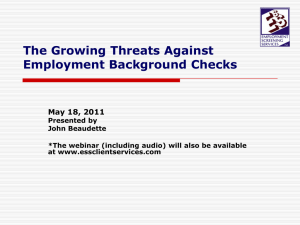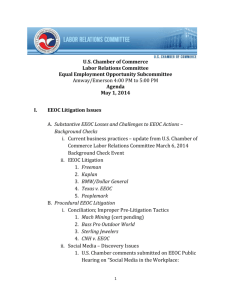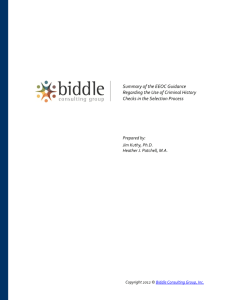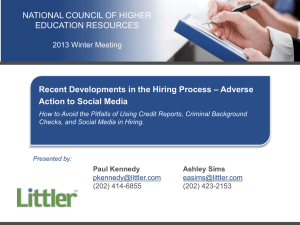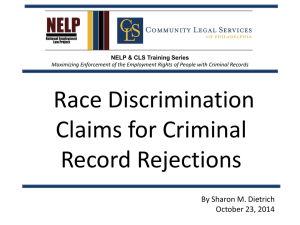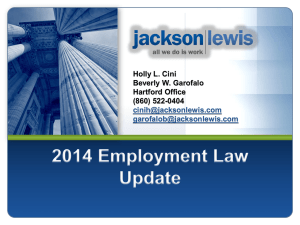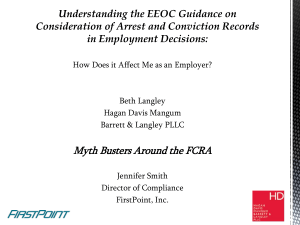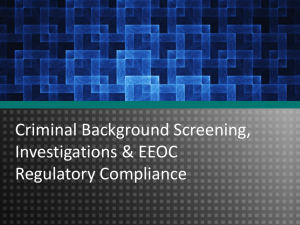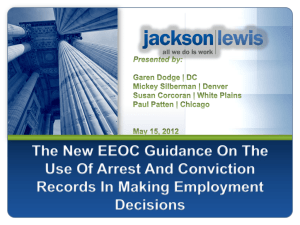What is a “Criminal Background Check”?
advertisement
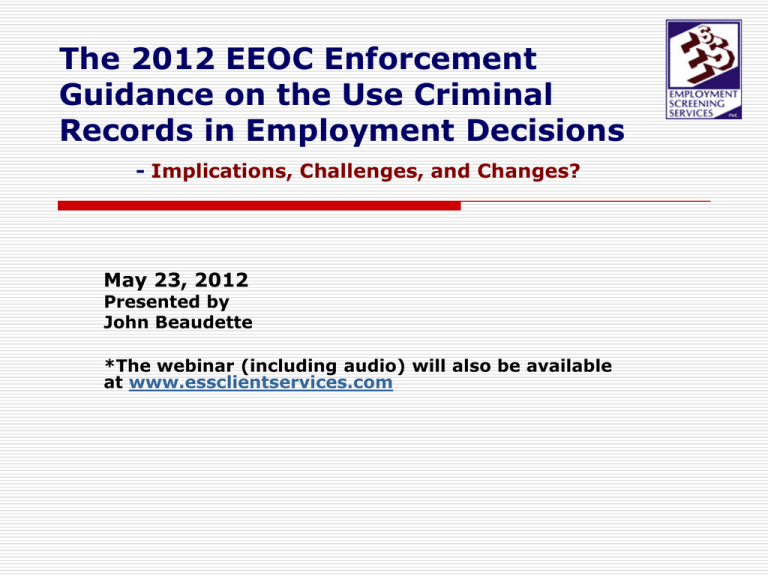
The 2012 EEOC Enforcement Guidance on the Use Criminal Records in Employment Decisions - Implications, Challenges, and Changes? May 23, 2012 Presented by John Beaudette *The webinar (including audio) will also be available at www.essclientservices.com ***OFFICIAL DISCLAIMER*** ESS Webinars and Presentations are presented for General Discussion Purposes Only. ESS does not provide legal advice and nothing presented or stated in ESS webinars, presentations, ESS websites, or by ESS personnel at this or any other time should be deemed or construed as legal guidance or legal opinion. You are urged to consult your legal department regarding your own situation and/or specific legal questions. EEOC 2012 Guidance NY Times: “must reading for all employers.” What Does the New EEOC Guidance Change? “Targeted Screen” “Individual Assessment” Sample Background Check Policy/Matrix To ask or not to ask? That is the criminal record question. Other EEOC Best Practice Recommendations EEOC - Enforcement Agency for Title VII of the Civil Rights Act of 1964 “The Set-up for 2012 Guidance” EEOC – long known for taking action against overt, intentional discrimination based on race, gender, national origin and other protected categories. • Disparate Treatment EEOC now focusing more on facially neutral selection criteria, such as credit reports and criminal records Disparate Impact on certain minority groups 92% of employers subject all or some of their job candidates to criminal background checks. African Americans make up 14% of population, but account for 28.8% of arrests, and 55% of drug arrests (drug use – no ethnic, racial disparity) A disclosed criminal record reduces chance for a job call back by 50%; significantly higher for African American men Ex-offenders unable to get a job are three times as likely to return to prison, than those who find employment. EEOC 2012 Guidance: “JR-BN and the Green Factors.” • Conviction constitutes reliable evidence, but still cannot be an automatic or absolute bar from employment Disparate Impact • Eighth Circuit Court identified these three factors as relevant to assessing whether an exclusion is job-related and consistent with a business necessity. (JR-BN) - Nature and gravity of the offense - Length of time since offense/release, completion of sentence - Nature of job sought/held These became known as the “Green” factors because they were first referenced in the 1975 court case, Green v. Missouri Pacific Railroad To establish that a criminal conduct exclusion is JR-BN the employer needs to show that its policy operates to effectively link specific the criminal conduct, and its dangers, with the risks inherent in the duties of a particular positions. The EEOC offers two ways employers to consistently meet JR-BN… EEOC Suggests Two Ways to Meet Job Related with Business Necessity (JR-BN) 1. Validate the Criminal Conduct for the Position in Question per Uniform Guidelines on Employee Selection Procedures. 2. If data is available – “studies are rare at this drafting” Use Targeted Screen, considering: The Green Factors - Nature and gravity of the offense - Length of time since offense/release, completion of sentence - Nature of job sought/held Individual Assessments - Notice to individual - may be screened out due to criminal record - Opportunity to demonstrate why JR-BN exclusion should not apply Targeted Screen – part 1 A Closer Look at the Green Factors 1. The Nature and Gravity of the Offense or Conduct 2. The Time Elapsed Since the Offense & Completion of Sentence 3. The harm caused by the crime – to person, property, society, no one Felonies are more severe than misdemeanors (in general) “Employer policies typically specify duration of a criminal conduct exclusion.” The EL court recognized that the amount of time passed since the criminal conduct was probative of the risk he imposed in the position in question. The Nature of the Job Held or Sought (potential risk) The nature of the duties; personal interaction, especially with the public and vulnerable populations Level of access to and usage of confidential, financial, and proprietary information, cash, property, and inventory. Level of supervision, oversight, monitoring “An employer may be able to justify a targeted screen exclusion solely under Green factors.” Target Screen part 2 “Individualized Assessment” Steps Mirror the FCRA Adverse Action Steps 1. Employer Notification to Applicant – informs the individual that he may be excluded because of past criminal conduct. “If you believe there is additional information that may help us better understand and evaluate your fitness for this position in light of the information in the attached consumer report, please contact us immediately.” 2. Opportunity for Applicant to respond EEOC Guidance, like FCRA adverse action steps – silent on how long to wait before exclusion is final 3. Employer consideration of what the applicant says on his own behalf - information is inaccurate, not pertain to individual - number of offenses for which individual was convicted older age at the time of release from prison evidence of same type of work post conviction length and consistency of employment since conviction rehabilitative efforts, training and education after conviction employment and character references whether the individual is bonded Sample Background Check Policy and Relevance Matrix Available at www.essclientservices.com - Downloadable Forms - Let’s do a quick review To Inquire, or Not to Inquire about Criminal History “As a best practice, and consistent with applicable laws, the Commission recommends that employers not ask about convictions on the job application and that, if and when they make such inquires, the inquiries be limited to convictions for which exclusions would be job related for the position in question and consistent with a business necessity.” Elizabeth Grossman, regional attorney for the New York District Office of the EEOC, in discussing the new guidance said that the question on the application -- “have you been convicted” – even with non disqualifying language is going to be viewed by the agency as a red flag. The Commission cites the fact that some states require employers to wait until late in the selection process to ask about conviction. This trend has become known as, “Ban the Box.” The Aspirations of “Ban the Box” Initiatives… By requiring employers to not ask about applicant criminal histories on the initial employment application, advocates hope – • Removes the deterrence of ex-offenders from even applying • Deters the employer from “sifting out” ex-offenders • Gives the ex-offender a chance to demonstrate qualifications, skills, experience • When a record is disclosed/found, forces the employer to take a closer look at job relevance, time elapsed, seriousness of offense, evidence of rehabilitation, other mitigating factors Advocates hope federal and state government “ban the box” policies will become a model to private employers and cause them to see the discrimination against ex-offenders as “invidious and unreasonable.” “Ban the Box” States and Municipalities: http://nelp.3cdn.net/14047d447967924539_zcm6bz5bp.pdf Implications of Removing the Criminal Question on the Initial Application What purpose is the question serving now? How can we make up for this purpose? SHOULD THE CRIMINAL QUESTION BE ASKED AT ALL? When should the question be asked and how (delivery)? • Take advantage of on-line processes What language should be used? • The Commission provides no examples Add Individual Assessment to the Criminal History Question? Following the criminal history question, you might consider adding: • Please list the type of offense and the date and location of conviction(s). • If you believe that the information above does not adequately reflect the circumstances surrounding the casers), or if there is additional information not submitted elsewhere that you believe the Company should be aware of in evaluating your fitness for this position, please provide that information below. How Worried Should Employers Be? EEOC took a unilateral in publishing the 2012 Enforcement Guidance and as a result are experiencing much push back. On Thursday, May 10, 2012, the House of Representatives approved 247-163 a fiscal year 2013 funding bill (H.R. 5326) for a variety of federal agencies, including the Equal Employment Opportunity Commission (EEOC), that includes a series of amendments that would curtail enforcement of certain laborand employment-related regulations and programs. These amendments would prohibit the use of any of the bill’s funds from being used by the EEOC or Department of Justice (DOJ) to: implement, administer, or enforce the new EEOC Enforcement Guidance: Consideration of Arrest and Conviction Records in Employment Decisions Another Webinar? Webinar: Understanding the EEOC’s New Criminal Records Guidance: Education and Enforcement Opportunities Wednesday, May 30, 2012 1:30 PM - 2:30 PM EDT Presenters: Maurice Emsellem, NELP Policy Co-Director Sharon Dietrich, CLS Managing Attorney Carol Miaskoff, EEOC Office of legal Counsel Pamela Paulk, Johns Hopkins Health Systems VP of Human Resources https://www2.gotomeeting.com/register/739059170 Questions? If you have any questions or would like to get in touch with me, please feel free to contact me at: johnb@employscreen.com 1-800-473-7778 x 101 *The webinar (including audio) will be available soon at www.essclientservices.com
